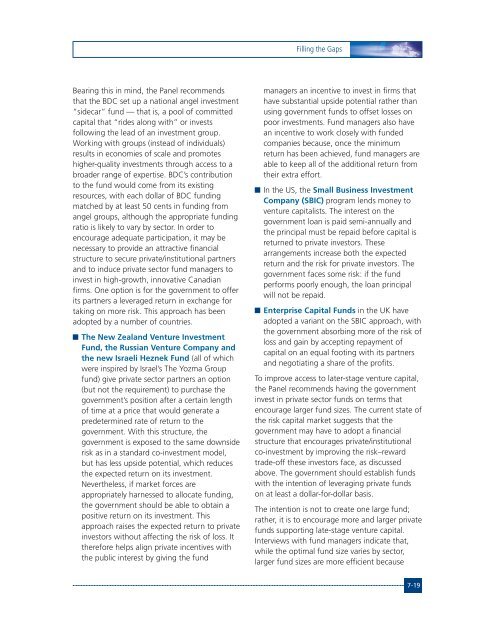Innovation Canada: A Call to Action
Innovation Canada: A Call to Action
Innovation Canada: A Call to Action
Create successful ePaper yourself
Turn your PDF publications into a flip-book with our unique Google optimized e-Paper software.
Filling the GapsBearing this in mind, the Panel recommendsthat the BDC set up a national angel investment“sidecar” fund — that is, a pool of committedcapital that “rides along with” or investsfollowing the lead of an investment group.Working with groups (instead of individuals)results in economies of scale and promoteshigher-quality investments through access <strong>to</strong> abroader range of expertise. BDC’s contribution<strong>to</strong> the fund would come from its existingresources, with each dollar of BDC fundingmatched by at least 50 cents in funding fromangel groups, although the appropriate fundingratio is likely <strong>to</strong> vary by sec<strong>to</strong>r. In order <strong>to</strong>encourage adequate participation, it may benecessary <strong>to</strong> provide an attractive financialstructure <strong>to</strong> secure private/institutional partnersand <strong>to</strong> induce private sec<strong>to</strong>r fund managers <strong>to</strong>invest in high-growth, innovative Canadianfirms. One option is for the government <strong>to</strong> offerits partners a leveraged return in exchange fortaking on more risk. This approach has beenadopted by a number of countries.The New Zealand Venture InvestmentFund, the Russian Venture Company andthe new Israeli Heznek Fund (all of whichwere inspired by Israel’s The Yozma Groupfund) give private sec<strong>to</strong>r partners an option(but not the requirement) <strong>to</strong> purchase thegovernment’s position after a certain lengthof time at a price that would generate apredetermined rate of return <strong>to</strong> thegovernment. With this structure, thegovernment is exposed <strong>to</strong> the same downsiderisk as in a standard co-investment model,but has less upside potential, which reducesthe expected return on its investment.Nevertheless, if market forces areappropriately harnessed <strong>to</strong> allocate funding,the government should be able <strong>to</strong> obtain apositive return on its investment. Thisapproach raises the expected return <strong>to</strong> privateinves<strong>to</strong>rs without affecting the risk of loss. Ittherefore helps align private incentives withthe public interest by giving the fundmanagers an incentive <strong>to</strong> invest in firms thathave substantial upside potential rather thanusing government funds <strong>to</strong> offset losses onpoor investments. Fund managers also havean incentive <strong>to</strong> work closely with fundedcompanies because, once the minimumreturn has been achieved, fund managers areable <strong>to</strong> keep all of the additional return fromtheir extra effort.In the US, the Small Business InvestmentCompany (SBIC) program lends money <strong>to</strong>venture capitalists. The interest on thegovernment loan is paid semi-annually andthe principal must be repaid before capital isreturned <strong>to</strong> private inves<strong>to</strong>rs. Thesearrangements increase both the expectedreturn and the risk for private inves<strong>to</strong>rs. Thegovernment faces some risk: if the fundperforms poorly enough, the loan principalwill not be repaid.Enterprise Capital Funds in the UK haveadopted a variant on the SBIC approach, withthe government absorbing more of the risk ofloss and gain by accepting repayment ofcapital on an equal footing with its partnersand negotiating a share of the profits.To improve access <strong>to</strong> later-stage venture capital,the Panel recommends having the governmentinvest in private sec<strong>to</strong>r funds on terms thatencourage larger fund sizes. The current state ofthe risk capital market suggests that thegovernment may have <strong>to</strong> adopt a financialstructure that encourages private/institutionalco-investment by improving the risk–rewardtrade-off these inves<strong>to</strong>rs face, as discussedabove. The government should establish fundswith the intention of leveraging private fundson at least a dollar-for-dollar basis.The intention is not <strong>to</strong> create one large fund;rather, it is <strong>to</strong> encourage more and larger privatefunds supporting late-stage venture capital.Interviews with fund managers indicate that,while the optimal fund size varies by sec<strong>to</strong>r,larger fund sizes are more efficient because7-19
















